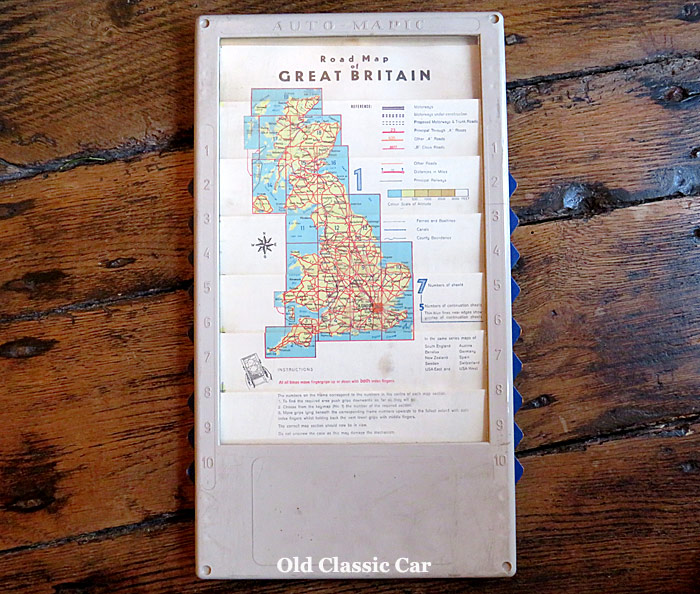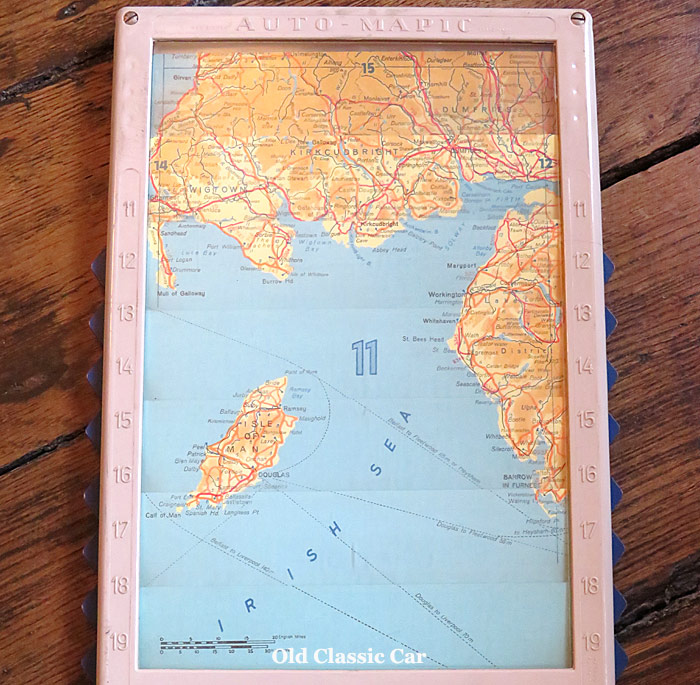Auto-Mapic road maps.
I've a couple of these ingenious Auto-Mapics, one of which was used by one of my grandfathers in the 1960s as he traversed the nation's highways, at the wheel of his company Austin or Morris 1100. No doubt he found it a great boon, containing as it does road maps of Great Britain in its entirety, within its compact 13" x 7.5" plastic casing.
|
|
In the 1950s and 1960s, the era when the Auto-Mapic was on sale, drivers seeking a route to their intended destination still had to engage their grey matter and work out a route, using whatever road maps they had close to hand. No Sat-Nav barking out orders in those days, compared to now where drivers/steering wheel operatives, usually unaware of their locality and instead placing absolute faith in a box of high-tech complication, simply go where they're told. No, fifty-plus years ago, maps - in conjunction with descriptive road signs and a modicum of common sense - were the order of the day, just as they had always been for motorists since the beginning of the 20th Century.
|
|
Large fold-out maps though are unwieldy beasts at best (see the old road maps section for examples), especially for a driver trying to get somewhere, and they take up valuable space inside a car, not least when maps for the entire country are needed. This is where the Auto-Mapic came into its own, in theory at any rate.
|

|
|
The example shown above dates to about 1960. It shows the country's first section of motorway, the Preston Bypass (opened December 1958), with the remainder of the eventual route for what would become the M6 provisionally marked out, but not yet implemented.
|
|
The Auto-Mapic is double-sided, with the first page given over to an overview of Great Britain, including details of which pages contain maps for which areas. Down each side are numbered cardboard tabs (I've seen them in red, and also blue), which can be slid up and down to change the map currently displayed in the viewing screen. Very handy indeed, although it's not unknown for individual pages within the unit to slip to one side, at a drunken angle. A warning on the front tells the user: "Do not unscrew the case as this may damage the mechanism", perhaps predicting that functionality may not always be seamless when it came to using the Auto-Mapic out on the road, but at least it didn't rely on batteries.
|
|
Auto-Mapics for other areas were also available. At the time of this example's production, drivers heading out on roads in, for example, New Zealand, Sweden, the USA, Germany, Spain and Austria could also specify an Auto-Mapic dedicated to these precise areas. I've read the suggestion that these were made in Austria, although I've found no firm evidence of this.
|

|
|
I've also read that the blank rectangle below the viewing screens would sometimes be populated with a car maker's stuck-on logo, Auto-Mapics being retailed by various car manufacturers at the time as a useful car accessory. Although neither of my examples has an original box, apparently the packaging contained the following glowing praise for the product within:
|
|
"The first fully automatic road map: automatic fingertip control moves large-scale maps into position as you travel. Every part of Great Britain comes progressively into view in the 9 3/4" x 6 1/4" clear plastic window of your Auto-Mapic. In addition all sections are numbered on a key map. Merely by moving your index fingers any section required is immediately visible. Safer and quicker to use than a folding map, the Auto-Mapic is a permanent solution to the road map problem. The precision and efficiency of the Auto-Mapic makes touring a pleasure. The perfect gift for the motorist."
|
|
Was it a usable device? In part yes, although you'd need good eyesight to routinely switch from looking out of the car windscreen, to the Auto-Mapic, and back outside again, especially in poor lighting. You'd also need great dexterity, as both hands were required to slide matching left and right sliders in unison, in order to change the map being viewed, none of which was - or is - recommended while driving, so not really "automatic" either, as implied by its name. It is though a very cool old car accessory, and one ideally suited to the interior of any classic 1950s or 1960s car today, unlike its modern counterpart.
|
|
Return to the motoring gadgets, tools & accessories pages at Old Classic Car.
|






